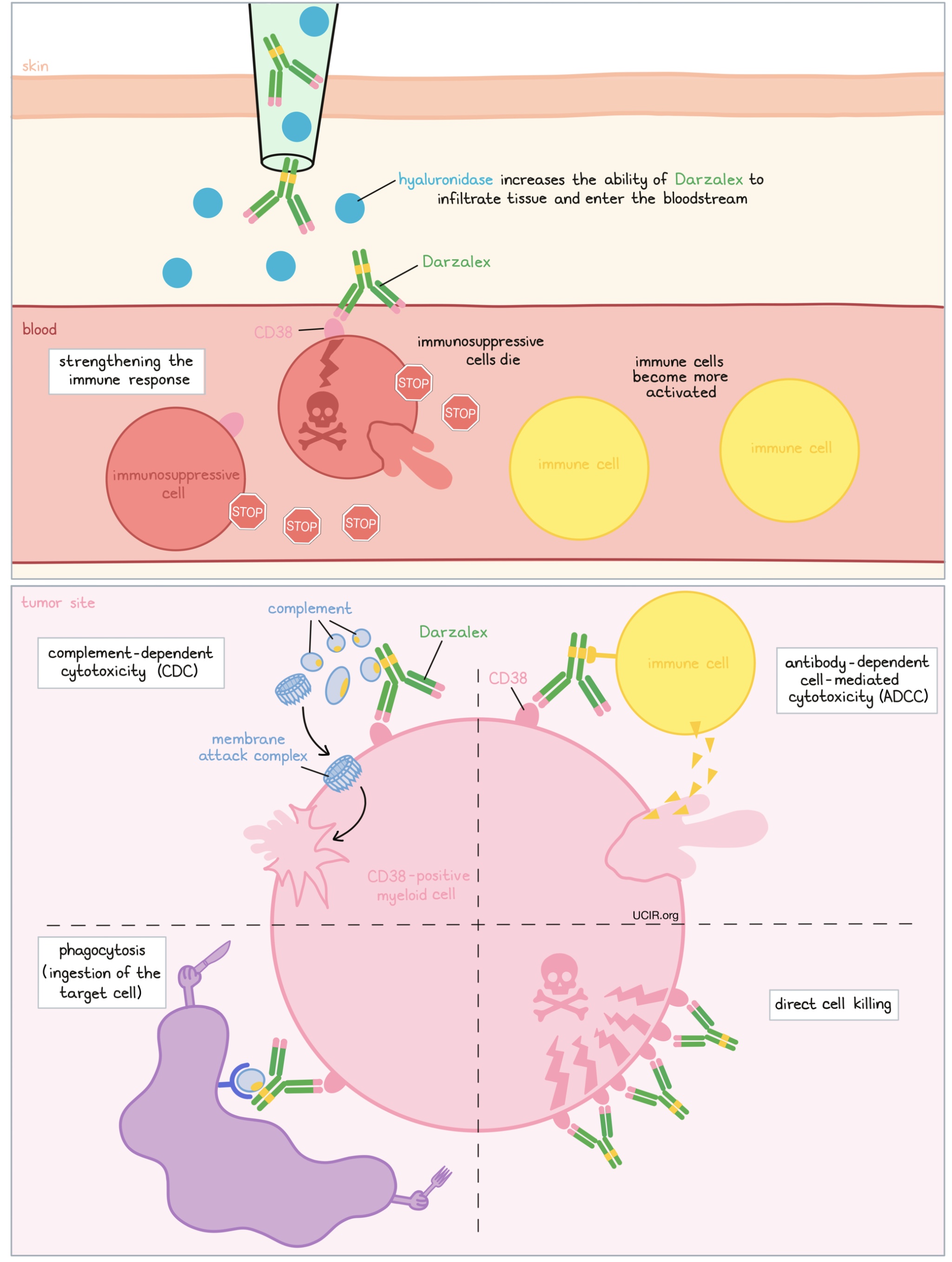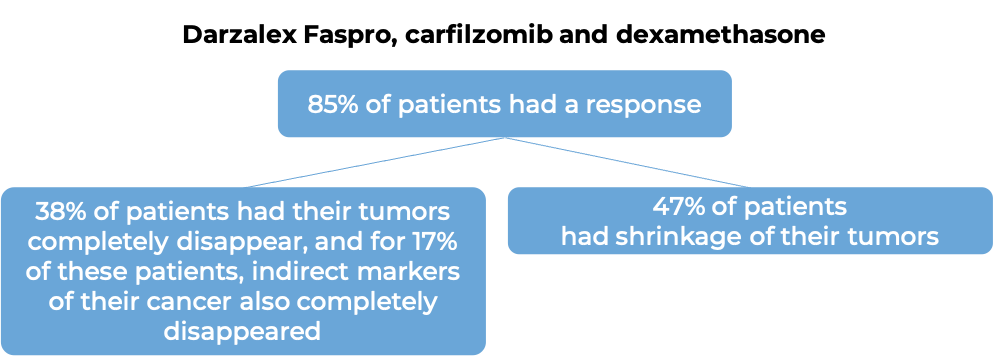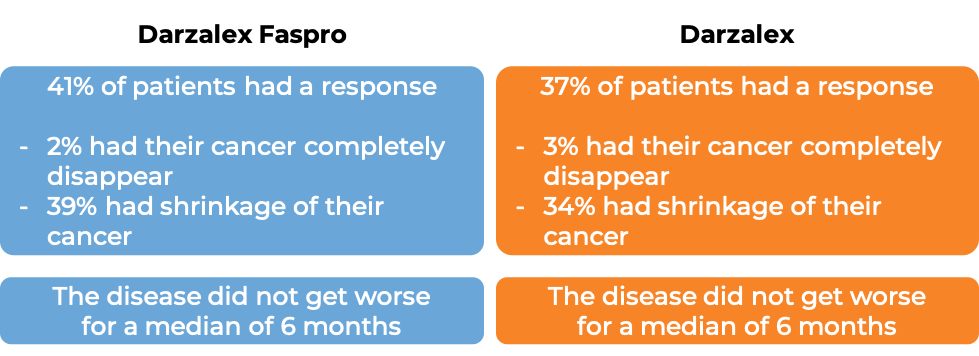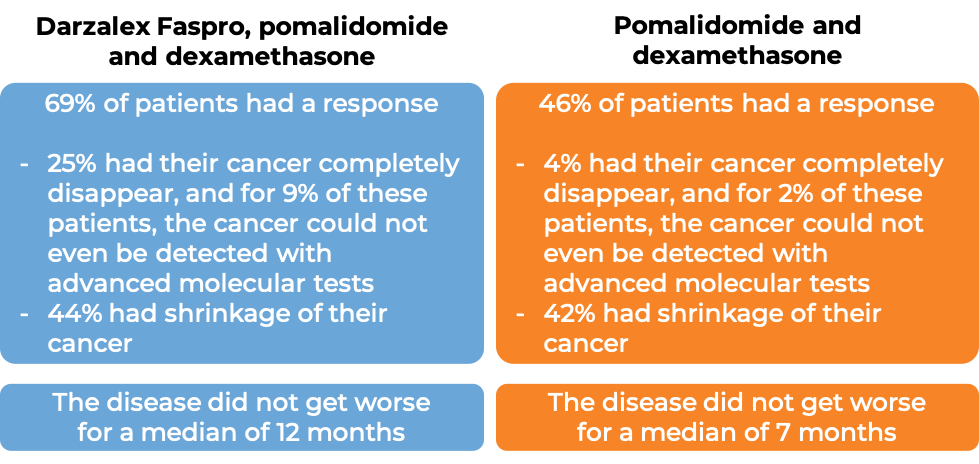How is this drug name pronounced?
Daratumumab, hyaluronidase: DAYR-uh-TOOM-yoo-mab and HY-al-yoo-RAH-nih-days
Darzalex Faspro: DAR-zah-lex FAS-proh
What cancer(s) does this drug treat?
Multiple myeloma (newly diagnosed)
Darzalex Faspro is approved for:
- Patients with newly diagnosed multiple myeloma who cannot receive an autologous stem cell transplant (stem cell transplant that uses their own stem cells). In such cases, Darzalex Faspro is used in combination with bortezomib (Velcade), melphalan, and prednisone, OR lenalidomide (Revlimid) and dexamethasone.
- Patients with newly diagnosed multiple myeloma who can receive an autologous stem cell transplant. In such cases, Darzalex Faspro is used in combination with bortezomib (Velcade), thalidomide, and dexamethasone.
Multiple Myeloma (previously treated)
Darzalex Faspro is approved for:
- Patients with multiple myeloma who have received at least one prior treatment for their disease, and it either did not work (refractory disease) or stopped working (relapsed disease). In such cases, Darzalex Faspro is used in combination with lenalidomide (Revlimid) and dexamethasone, or in combination with carfilzomib (Kyprolis) and dexamethasone.
- Patients with multiple myeloma who have received at least one prior treatment for their disease, including lenalidomide (Revlimid) and a proteasome inhibitor (e.g., bortezomib). In such cases, Darzalex is used in combination with pomalidomide (Pomalyst) and dexamethasone.
- Patients with multiple myeloma who have received at least one prior treatment for their disease. In such cases, Darzalex Faspro is used in combination with bortezomib (Velcade) and dexamethasone.
- Patients with multiple myeloma who have received at least three prior treatments for their disease, including a proteasome inhibitor (e.g., bortezomib) and an immunomodulatory agent (e.g., lenalidomide or thalidomide), or for whom both a proteasome inhibitor and an immunomodulatory agent did not work. In such cases, Darzalex Faspro is used by itself.
Limitations of use:
Age: The safety and efficacy of Darzalex Faspro in patients under 18 years of age have not been established.
Hypersensitivity: Darzalex Faspro should not be used for treatment of patients with a history of severe reactions (hypersensitivity) to daratumumab, hyaluronidase, or any components of the formulation.
Pregnancy/Breastfeeding: The risks associated with Darzalex Faspro during pregnancy are not known and cannot be ruled out. Due to the potential for harm to the fetus, Darzalex Faspro is not recommended for use during pregnancy. Women are advised to use contraception during treatment with Darzalex and for at least 3 months after the last dose of Darzalex Faspro. The risks associated with Darzalex Faspro during breastfeeding are not known and cannot be ruled out. Due to the potential for adverse reactions in the breastfed child, women are advised not to breastfeed during treatment with Darzalex Faspro.
In some cases, Darzalex Faspro is used in combination with lenalidomide or thalidomide. This treatment can cause harm to a fetus, including severe, life-threatening birth defects, and is not recommended for use during pregnancy. Patients are advised to also refer to the lenalidomide and thalidomide prescribing information for contraception requirements.
What type of immunotherapy is this?
- Cell-killing antibody
How does this drug work?
- Target: CD38
Darzalex Faspro is a combination treatment of daratumumab (Darzalex) and hyaluronidase. Darzalex is the therapeutic component of the treatment, while hyaluronidase is added to increase the ability for Darzalex to infiltrate into tissue under the skin and enter the bloodstream.
Darzalex is an antibody that was made in the laboratory. Darzalex and other antibody molecules have an overall “Y” shape. The two tips of the upper arms of the “Y” shape are the parts of the antibody that can very precisely bind to their targets. Darzalex attaches to a molecule called CD38. CD38 plays a role in the attachment of neighboring cells to each other, and in transmitting messages from the outside of the cell to the inside of the cell. CD38 is present on the surface of many types of immune cells (white blood cells) and red blood cells, but is found in higher amounts on the surface of myeloma cells. The stem of Darzalex’s “Y” shape has binding sites that attract immune cells or other parts of the immune system.
At least five different mechanisms are thought to be responsible for the elimination of myeloma cells by Darzalex. Darzalex works alone and/or is helped by the immune system to kill myeloma cells
Direct cell killing
By binding to CD38 molecules on the surface of myeloma cells and bringing the CD38 molecules close together in “clusters”, Darzalex can directly cause the cells to die.
Complement-dependent cytotoxicity (CDC)
When bound to CD38 on the surface of myeloma cells, the “stem” of Darzalex can attract and bind molecules of the immune system called “complement” that freely flow in the blood or tissues. Activation of the complement system causes the formation of the “membrane attack complex”, which can puncture and destroy the cell that Darzalex is bound to.
Antibody-dependent cell-mediated cytotoxicity (ADCC)
When bound to CD38 on the surface of myeloma cells, the “stem” of Darzalex can also attract and bind immune cells. This allows Darzalex to act as a bridge between the target cells and the immune cells (such as the natural killer (NK) cells). The immune cells then release molecules that can kill the cells that Darzalex is bound to.
Phagocytosis
When Darzalex is bound to myeloma cells, it can also attract immune cells called phagocytes, which have the ability to ingest (“eat”) cells that have been coated with Darzalex.
Strengthening the immune response
Darzalex can bind to CD38 on the surfaces of certain types of immunosuppressive immune cells that reduce the strength of an immune response, causing such cells to die. At the same time, Darzalex can activate immune cells that are required for the elimination of cancer cells, thus allowing for a stronger immune attack on myeloma cells.
The combined effect of these mechanisms results in the elimination of melanoma from the body. Because CD38 is also found on certain normal cells, Darzalex can attack and reduce the numbers of some types of immune cells, including healthy B cells and natural killer (NK) cells.

How is this drug given to the patient?
About 1 to 3 hours prior to receiving each dose of Darzalex Faspro, patients receive several medications to help reduce the chance of a reaction to the infusion:
- A corticosteroid (dexamethasone or methylprednisolone)
- An antihistamine (diphenhydramine)
- A painkiller and fever reducer (acetaminophen)
Darzalex Faspro is administered via an injection under the skin (subcutaneous [s.c.] injection) of the abdomen every one, two, three, or four weeks, depending on the treatment regimen and how long the patient has been receiving Darzalex Faspro. A typical injection of Darzalex Faspro takes 3-5 minutes. In most cases, Darzalex Faspro is administered in combination with other medications. In such cases, a corticosteroid may be part of the treatment regimen, and no additional corticosteroid is given before the Darzalex Faspro injection.
Patients may receive corticosteroids after each infusion of Darzalex to reduce the risk of a delayed reaction to the infusion.
Patients receive antiviral medication to prevent herpes zoster (shingles) reactivation, beginning within 1 week of starting Darzalex and continuing for 3 months after treatment.
What are the observed clinical results?
For:
Multiple Myeloma (newly diagnosed)
Multiple Myeloma (previously treated)
It is important to keep in mind that each patient’s actual outcome is individual and may be different from the results found in the clinical studies. In addition, with immunotherapy, sometimes it takes several months for responses to be observed.
Multiple Myeloma (newly diagnosed)
In a clinical trial, 67 patients with newly diagnosed multiple myeloma who could not receive an autologous stem cell transplant, were treated with Darzalex Faspro plus bortezomib, melphalan, and prednisone (D-VMP). At a minimum follow-up of 10 months, 88% of patients saw their cancer shrink in response to the treatment, with 18% seeing their cancer disappear entirely.
Multiple myeloma (previously treated)
In a clinical trial, 65 patients with multiple myeloma whose cancer had been previously treated, but it either did not respond to treatment (refractory) or had since returned (relapsed), were treated with Darzalex Faspro plus lenalidomide and dexamethasone (D-Rd). At a minimum follow-up of 10 months, 91% of patients saw their cancer shrink in response to the treatment, with 18% seeing their cancer disappear entirely.
In another clinical trial, 66 patients with multiple myeloma whose cancer had been previously treated, but it either did not respond to treatment (refractory) or had since returned (relapsed), were treated with Darzalex Faspro plus carfilzomib and dexamethasone (D-Kd). At a median follow-up of 9 months:
It has been estimated that 83% of the patients who responded to therapy maintained this response for at least 9 months.

It has been estimated that 83% of the patients who responded to therapy maintained this response for at least 9 months.
In another clinical trial, 522 patients with multiple myeloma who had received at least 3 prior treatments, including a proteasome inhibitor and an immunomodulatory agent, but whose cancer either did not respond to treatment (refractory) or had returned since treatment (relapsed), were randomized to receive either Darzalex Faspro or intravenous daratumumab (Darzalex). This trial was set out to study whether Darzalex Faspro and Darzalex would deliver a similar benefit to patients. At a median follow-up of 8 months:

In another clinical trial, 304 patients with multiple myeloma who had received at least one prior treatment for their disease, including lenalidomide and a proteasome inhibitor (e.g., bortezomib) were treated with either:
- Darzalex Faspro, pomalidomide and dexamethasone, OR
- pomalidomide and dexamethasone alone.
At a median follow-up of 17 months:

(For the definition of “median”, click HERE)
What are the side effects?
The most common side effects of Darzalex Faspro when used alone include cold-like symptoms (upper respiratory infection). The most common side effects of Darzalex Faspro used in combination therapy include fatigue, nausea, diarrhea, constipation, vomiting, shortness of breath, cough, high blood pressure, trouble sleeping, fever, chills, muscle spasms, headache, back pain, nerve damage (tingling, numbness, or pain), swelling of lower legs and hands, and lung infection (pneumonia).
Darzalex Faspro can cause side effects that can become serious or life-threatening. Some of the serious side effects related to Darzalex Faspro include heart problems (especially in patients with light chain amyloidosis), severe allergic or other reactions related to the injection of Darzalex Faspro, low white blood cell count (which can lead to severe infections), and low platelet count (which can lower the ability to clot blood). Problems with the eyes and vision may also occur.
Darzalex Faspro may interfere with the results of blood tests that are needed before a patient can receive a blood transfusion. Tests to match a patient’s blood type should be done before the first dose of Darzalex.
Patients should report any symptoms to their healthcare provider, who can then initiate actions to limit or reverse the side effects. For a more complete list of possible side effects, see the full prescribing information.
Additional information
Manufacturer
Janssen Biotech
Approval
FDA
Links to drug websites
Other references:
- Subcutaneous versus intravenous daratumumab in patients with relapsed or refractory multiple myeloma (COLUMBA): a multicentre, open-label, non-inferiority, randomised, phase 3 trial. Mateos MV, et al. The Lancet Haematology (2020)
- Daratumumab plus pomalidomide and dexamethasone versus pomalidomide and dexamethasone alone in previously treated multiple myeloma (APOLLO): an open-label, randomised, phase 3 trial. Dimopoulos MA, et al. The Lancet Oncology (2021)
Last updated: January 17, 2023


